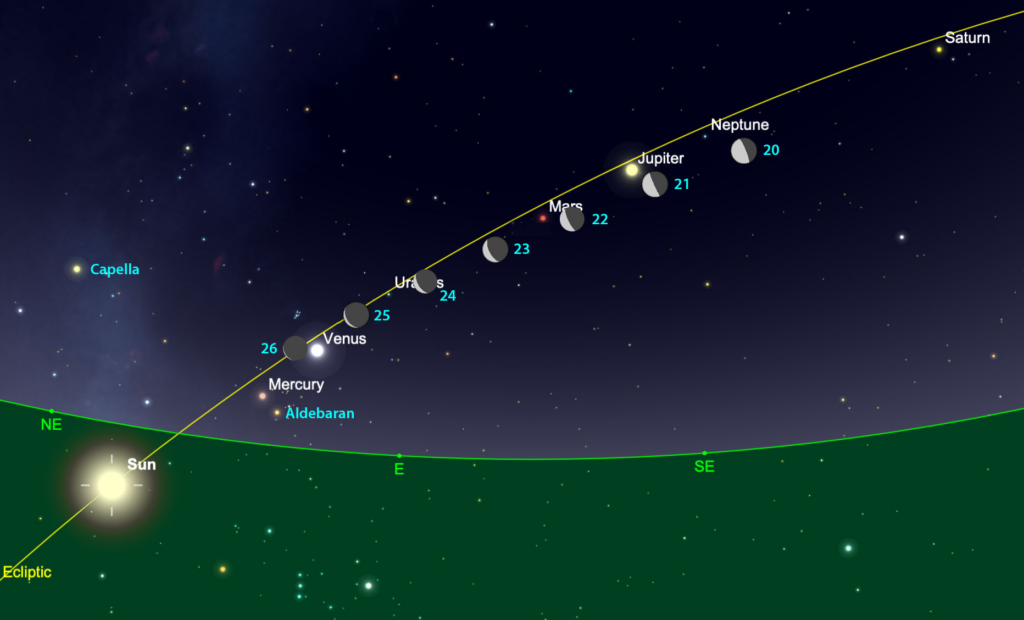Sky Report: June 20-26

The planets 45 min before sunrise; Mercury’s position is for June 23. They appear in the same order in the sky (L to R) as they orbit the sun. The moon is shown daily. The horizon is translucent so you can see the sun. Graphic created with SkySafariAstronomy.com.
This is the best week to see all the planets, plus the moon, lined up in the morning sky. Astronomy blogs are making a big deal about it and I will too. The novelty is in seeing ALL planets at once, including Uranus and Neptune if you have at least binoculars, but additionally all the naked-eye classical planets are seen in the same order that they orbit the sun. And the moon passes each of them in turn. All you have to do is get up a bit early and look up.
In order from east to west, and in order of their distance from the sun, they are:
Mercury, only a few degrees high in the east-southeast 45 minutes before sunrise. There’s a narrow window of time to see it – as soon as it has risen but before the sky becomes too light. Fortunately Mercury is quite bright. Use binoculars. You might, but probably won’t, notice the nearby fainter star Aldebaran.
Venus is brilliant and unmistakable. Use Venus to find Mercury, which is 10° from it at the 7 o’clock position.
Mars is the faintest naked-eye planet but it’s higher and so is easy to spot, three-quarters of the way from Venus to Jupiter.
Jupiter is the second brightest planet, sitting half-way up the southeastern sky.
Saturn is almost as far to the right of Jupiter as Jupiter is from Venus
Uranus and Neptune are there too, but you’ll need a star map and binoculars or better yet a small telescope.
The planets form a line, called the ecliptic, because the solar system is flat and we see it edge-on. Only the moon deviates from this plane enough to matter.
The moon adds to the show! It was nearest to Saturn on the 18th, but it passes each planet in turn as it orbits the earth, moving eastward approximately 13° per day. It’s 4° from Jupiter on the 21st, 4° from Mars on the 22nd, less than 4° from Venus on the 26th, and 4° from Mercury on the 27th (that morning the moon is such an ultra-thin crescent you probably won’t see it.) The field of view of most binoculars is 5-7°, so each of these mornings you can see the moon and a planet together.
Pluto is up too, and at the same time, if you insist that it retain its status as a planet. It’s in the southwest, in eastern Sagittarius, almost 30° from Saturn. But you’ll need a substantial telescope to see it.
A reminder yet again: the width of your fist at arm’s length is 10°, and by far the best star charts for finding faint objects like Uranus and Neptune are planetarium apps for your smart phone and tablet computer.
Summer begins at 3:13 a.m. MDT on Tuesday the 21st. That’s the moment when the sun is as far north of the celestial equator as it will be for the year. The Farmer’s Almanac (online) has the best description of what happens then.
Stellar Vista Observatory provides portable telescopes and tripod mounted binocular kits on loan for free to residents and visitors in Kane County. Enhance your enjoyment of the night sky! For details or to request a loan, visit https://stellarvistaobservatory.org/discover-the-night-sky/ or drop in to the Kane County Office of Tourism.
The Sky Report is presented as a public service by the Stellar Vista Observatory, a nonprofit organization based in Kanab, Utah, which provides opportunities for people to observe, appreciate, and comprehend our starry night sky. Additional information is at www.stellarvistaobservatory.org. Send questions and comments to John@StargazingAdventures.org.






Comments are closed.